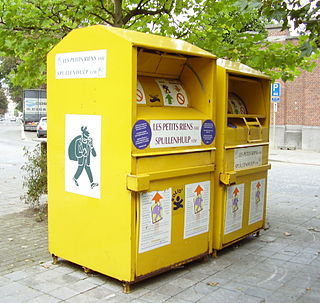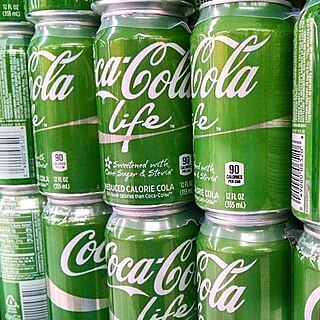Green consumption is related to sustainable development or sustainable consumer behaviour. It is a form of consumption that safeguards the environment for the present and for future generations. It ascribes to consumers responsibility or co-responsibility for addressing environmental problems through the adoption of environmentally friendly behaviors, such as the use of organic products, clean and renewable energy, and the choice of goods produced by companies with zero, or almost zero, impact (zero waste, zero-emissions vehicle, zero-energy building, etc.). [1]
In Western societies, green consumption emerged during the 1960s and the early 1970s, with the increased awareness of the necessity to protect the environment and people's health from the effects caused by industrial pollutants and by economic and population growth. In the 1980s, the first American green brands began to appear and exploded on the American market. During the 1990s, green products grew slowly, remaining a niche phenomenon. American interest in green products started to increase again in the early 2000s and have continued to grow. [2]
After the oil crisis of 1973, people in western countries began to consider the use of green energy as an alternative to fossil fuels. Now green consumption is considered a basic point of environmental reform and it is also guaranteed by supra-national organizations like the European Union. Some sociologists [ who? ] argue that increasing globalization led people to feel more interconnected with others and the environment, which led to an increasing awareness of global environmental problems, especially in western countries.
The main forums in which the issue has been discussed, and which have provided guidelines to orient national governments are: Stockholm 1972 UN Conference on the Human Environment; IUCN 1980 World Conservation Strategy; World Commission on Environment and Development in 1983 and 1987 Brundtland Report; Italy 1993 National Plan for Sustainable Development; Aalborg 1994, 1st European Conference on Sustainable Cities; Lisbon 1996, 2nd European Conference on Sustainable Cities; Hannover 2000, 3rd Conference on Sustainable Cities; European Union in 2001, VI Environmental Action Plan 2002/2010; Aalborg +10; and the Aalborg Commitments in 2004.
Green consumer behavior is a form of pro-environmental behavior, a form of consumption that harms the environment as little as possible or even benefits the environment. [3] Research provides empirical support to the claim that green or pro-environmental consumer behavior is composed of: [4]
Contextual factors like monetary incentives, costs, regulations, and public policy norms, as well as subjectively perceived factors such as perceived resources available [6] influence consumer pro-environmental behavior and thus green consumption through the mediating effect of attitudes. [4] It is through attitude that subjectively perceived contextual factors such as the extent to which consumers perceive having more or less time, money, and power available, modulate pro-environmental behavior in general, and green consumption in particular.
Green consumer behavior has the following characteristics:
A green consumer is "one who purchase products and services perceived to have a positive (or less negative) influence on the environment…" [9] Green consumers act ethically, motivated not only by their personal needs, but also by the respect and preservation of the welfare of entire society, because they take into account the environmental consequences (costs and benefits) of their private consumption. Green consumers are more conscientious in their use of assets, for example by using their goods without wasting resources. However the Eurobarometer's survey of consumers’ behavior (2013) showed that consumers seem not to place importance on adopting a set of new behaviors that are more environmentally-friendly. That report[ citation needed ] stated that even though a very high proportion of citizens buy green products (80%), more than half are classified as occasional maintenance[ clarification needed ] (54%), and only a quarter are regular buyer of green products (26%). This suggests that most people do not behave like green consumers continuously, probably because of social and economic constraints, such as the fact that green products can be more expensive than non-green ones, or because it is not always easy to find green goods for each category, and green retailers are not so widespread. Some researchers[ who? ] find that personal values are influential determinants of consumption and that pro-environmental behavior might serve as a signal of personality dimension[ clarification needed ]. There are two types of consumers:
Another researcher finds an effect of gender and social identity on green consumption: [ clarification needed ]"female declared higher levels of sustainable consumption compared with male participants; however when social identity is salient, male increased their sustainable consumption intentions to the same level as female. [8] In this research are identified two kind of people, that have more:
Sustainable consumption is, for men, a way to reinforce their social image, showing to others that they care about environment, whereas for women sustainable consumption is intrinsically important. The evidence is that green consumers are mainly female, aged between 30 and 44 years old, well educated, in a household with a high annual income. [8]
Green energy includes natural energetic processes that can be harnessed with little pollution.
Demand for less environmentally-damaging food production leads people to buy more organic and local food. Organic food is produced through agriculture that does not use artificial chemical fertilizers and pesticides, and animals reared in more natural conditions, without the routine use of drugs, antibiotics, and dewormers common in intensive livestock farming. Consumers can also choose to buy local food in order to reduce the social and environmental impacts of "food miles" – the distance food travels between being produced and being consumed. This behavior can create a new sense of connection with the land, through a concern for the authenticity and provenience of the food eaten, operating as a social as much as a technological innovation. [11] Taste, health, and safety concerns can be other reasons behind this consumption practices.
Three reasons that motivate the purchase of organic cloths are:
The textile and clothing industry generates much pollution and consumes many resources. Improper use and disposal of clothing products make the problems much more severe. Consumers who are concerned about these (environmental) issues, are best motivated to change their behaviors via philanthropic or environmental-friendly actions that adapt with their financial and sustainability interests. An intuitive and sustainable strategy is clothing reuse. Textile recycling is a method of reprocessing used clothing, fibrous material, and clothing scraps from the manufacturing process. This can reduce manufacturing pollution and resource consumption. [13] Consumers may pay attention to the origin and the materials of the clothes they buy and whether they are harmful to the environment. [14] Consumers often have a lack of information of green fashion or are unaware of the existence of green fashion alternatives to traditional adult fashion. [ original research? ]
Industrial ecology (IE) is the study of material and energy flows through industrial systems. The global industrial economy can be modelled as a network of industrial processes that extract resources from the Earth and transform those resources into by-products, products and services which can be bought and sold to meet the needs of humanity. Industrial ecology seeks to quantify the material flows and document the industrial processes that make modern society function. Industrial ecologists are often concerned with the impacts that industrial activities have on the environment, with use of the planet's supply of natural resources, and with problems of waste disposal. Industrial ecology is a young but growing multidisciplinary field of research which combines aspects of engineering, economics, sociology, toxicology and the natural sciences.
Ethical consumerism is a type of consumer activism based on the concept of dollar voting. People practice it by buying ethically made products that support small-scale manufacturers or local artisans and protect animals and the environment, while boycotting products that exploit children as workers, are tested on animals, or damage the environment.
A sustainable business, or a green business, is an enterprise with a minimal negative impact or potentially a positive effect on the global or local environment, community, society, or economy. This business attempts to meet the triple bottom line. They cluster under different groupings, and the whole is sometimes referred to as "green capitalism." Often, sustainable businesses have progressive environmental and human rights policies. In general, a business is described as green if it matches the following four criteria:
Sustainability advertising is communications geared towards promoting social, economic and environmental benefits (sustainability) of products, services or actions through paid advertising in media in order to encourage responsible behavior of consumers.
Green marketing is the marketing of products that are presumed to be environmentally safe. It incorporates a broad range of activities, including product modification, changes to the production process, sustainable packaging, as well as modifying advertising. Yet defining green marketing is not a simple task. Other similar terms used are environmental marketing and ecological marketing.

Textile recycling is the process of recovering fiber, yarn, or fabric and reprocessing the material into new, useful products. Textile waste is split into pre-consumer and post-consumer waste and is sorted into five different categories derived from a pyramid model. Textiles can be either reused or mechanically/chemically recycled.

The value-action gap is the discrepancy between the stated values of an individual or organisation and their actions. More generally, it is the difference between what people say and what people do. The phrase is associated with environmental geography, relating to attitudes and behaviors surrounding environmental issues. Numerous studies have reported an increase in global environmental concern, but have shown that environmental engagement is not adjusting in accordance.

Sustainable fashion is a term describing efforts within the fashion industry to reduce its environmental impacts, protect workers producing garments and uphold animal welfare. Sustainability in fashion encompasses a wide range of factors, including cutting CO2 emissions, addressing overproduction, reducing pollution and waste, supporting biodiversity and ensuring that garment workers are paid a fair wage and have safe working conditions.

A green company, also known as an environmentally friendly or sustainable business, is an organization that conducts itself in a way that minimizes harm to the environment. Examples of these actions may include the conservation of natural resources, efforts to reduce carbon emissions, a reduction of waste creation, and support of ecological conservation. Green companies often implement environmentally responsible practices across their entire value chain, from sourcing raw materials to manufacturing processes and distribution.

Ecological design or ecodesign is an approach to designing products and services that gives special consideration to the environmental impacts of a product over its entire lifecycle. Sim Van der Ryn and Stuart Cowan define it as "any form of design that minimizes environmentally destructive impacts by integrating itself with living processes." Ecological design can also be defined as the process of integrating environmental considerations into design and development with the aim of reducing environmental impacts of products through their life cycle.

Sustainable diets are "dietary patterns that promote all dimensions of individuals’ health and wellbeing; have low environmental pressure and impact; are accessible, affordable, safe and equitable; and are culturally acceptable". These diets are nutritious, eco-friendly, economically sustainable, and accessible to people of various socioeconomic backgrounds. Sustainable diets attempt to address nutrient deficiencies and excesses, while accounting for ecological phenomena such as climate change, loss of biodiversity and land degradation. These diets are comparable to the climatarian diet, with the added domains of economic sustainability and accessibility.

Sustainable packaging is packaging materials and methods that result in improved sustainability. This involves increased use of life cycle inventory (LCI) and life cycle assessment (LCA) to help guide the use of packaging which reduces the environmental impact and ecological footprint. It includes a look at the whole of the supply chain: from basic function, to marketing, and then through to end of life (LCA) and rebirth. Additionally, an eco-cost to value ratio can be useful The goals are to improve the long term viability and quality of life for humans and the longevity of natural ecosystems. Sustainable packaging must meet the functional and economic needs of the present without compromising the ability of future generations to meet their own needs. Sustainability is not necessarily an end state but is a continuing process of improvement.
Sustainable consumption is the use of products and services in ways that minimizes impacts on the environment.

Micro-sustainability is the portion of sustainability centered around small scale environmental measures that ultimately affect the environment through a larger cumulative impact. Micro-sustainability centers on individual efforts, behavior modification, education and creating attitudinal changes, which result in an environmentally conscious individual. Micro-sustainability encourages sustainable changes through "change agents"—individuals who foster positive environmental action locally and inside their sphere of influence. Examples of micro-sustainability include recycling, power saving by turning off unused lights, programming thermostats for efficient use of energy, reducing water usage, changing commuting habits to use less fossil fuels or modifying buying habits to reduce consumption and waste. The emphasis of micro-sustainability is on an individual's actions, rather than organizational or institutional practices at the systemic level. These small local level actions have immediate community benefits if undertaken on a widespread scale and if imitated, they can have a cumulative broad impact.
Sustainable products are products either sustainably sourced, manufactured or processed and provide environmental, social, and economic benefits while protecting public health and the environment throughout their whole life cycle, from the extraction of raw materials to the final disposal.
Sustainable consumer behavior is the sub-discipline of consumer behavior that studies why and how consumers do or do not incorporate sustainability priorities into their consumption behavior. It studies the products that consumers select, how those products are used, and how they are disposed of in pursuit of consumers' sustainability goals.

Cotton recycling is the process of converting cotton fabric into fibers that can be reused into other textile products.

Organic food culture refers to a recent social and cultural trend in which there has been an increased interest in organic food due to the rise of media coverage on health, food safety, and environmental dangers of pesticides. This attitude considers food a central requirement for health, but it does not neglect the aesthetic or hedonistic (pleasurable) aspects of food consumption.

Slow fashion is an aspect of sustainable fashion and a concept antithetical to fast fashion. It is part of the "slow movement" advocating for clothing and apparel manufactured with respect to people, the environment and animals. As such, contrary to the industrial practices of fast fashion conglomerates, slow fashion involves local artisans and the use of eco-friendly materials.

The fashion industry, particularly manufacture and use of apparel and footwear, is a significant driver of greenhouse gas emissions and plastic pollution. The rapid growth of fast fashion has led to around 80 billion items of clothing being consumed annually, with about 85% of clothes consumed in United States being sent to landfill.